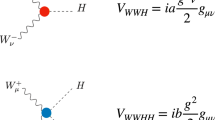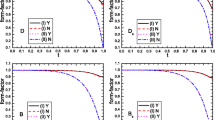Summary
The bootstrap mechanism ofZachariasen andZemach (3) is used to study the resonant scattering of pseudoscalar mesons under the assumption of mass degeneracy and the existence of the vector resonances. The general bootstrap conditions on the mass and the coupling constants are formulated andCapps’ result (6) onSU 3 symmetry is rederived from our more general equations. The question of the possible existence of further resonances is reduced to a simple eigenvalue problem. The forces due to the vector exchange are found to be repulsive in the 10,\(\overline {10} \) and 27SU 3 channels but attractive in the 1 and 8, and when calculated with the self-consistent parameters are strong enough to bind scalar resonances in the 1 and 8 channels. These resonances may contribute to the interaction forces. Taking into account the scalar octet exchange in addition to the vector exchange we have bootstrapped the two octets together in a double self-consistency calculation. A self-consistent solution is obtained atm v ∼ 1000 MeV,m s ∼ 500 MeV, and a small value for the ratio of the scalar coupling strength to the vector coupling strength (5%). The singlet scalar meson has not been bootstrapped for the sake of simplicity, but we have some reasons to believe that its effect should be small. We have tentatively assigned the weakly coupled K’ (725) to theI=1/2 members of the scalar octet, the K1K1 threshold anomaly to theI=0 member of the octet, and the ABC «particle» to the scalar unitary singlet. Spin 2+ «particles» are also predicted using the self-consistent parameters in the 1 and 8 channels at higher energies, the singlet being here tentatively identified as f0 while the octet occurs at presumably too high energies to be seen. Because of the crudeness of the model, no quantitative significance of the results is claimed, but the model is expected to be qualitatively correct and to give the right orders of magnitude for the various parameters.
Riassunto
Si adopera il meccanismo a «bootstrap» diZachariasen eZemach per studiare lo scattering di risonanza dei mesoni pseudoscalari nell’ipotesi della degenerazione della massa e dell’esistenza di risonanze vettoriali. Si formulano le condizioni generali di «bootstrap» per la massa e la costante di accoppiamento e si riottengono i risultati diCapp sulla simmetriaSU 3 in base alle nostre equazioni più generali. La questione della possibile esistenza di ulteriori risonanze è ridotta ad un semplice problema di autovalori. Si trova che le forze dovute a scambio vettoriale repulsive nei canali 10,\(\overline {10} \) e 27SU 3 ma attrattive in quelli 1 e 8, e che quando sono calcolate con i parametri autocoerenti sono abbastanza forti da legare le risonanze scalari nei canali 1 e 8. Queste risonanze possono contribuire alle forze di interazione. Tenendo conto dello scambio dell’ottetto scalare, oltre allo scambio vettoriale, si è applicato il metodo del «bootstrap» ai due ottetti contemporaneamente in un doppio calcolo di autocoerenza. Si ottiene una soluzione autocoerente am v ∼ 1000 MeV,m s ∼ 500 MeV, ed un piccolo valore per il rapporto fra la forza dell’accoppiamento scalare e la forza dell’accoppiamento vettoriale (5%). Per semplicità il metodo del «bootstrap» non è stato applicato al mesone scalare singoletto, ma abbiamo motivi per ritenere che il suo effetto deve essere piccolo. In via di tentativo si è assegnato il K’ (725), debolmente accoppiato, ai membriI=1/2 dell’ottetto scalare, l’anomalia di soglia K1K1 al membroI=0 dell’ottetto, e la «particella» ABC al singoletto scalare unitario. Facendo uso dei parametri autocoerenti nei canali 1 e 8 ad energie più alte, si prevedono anche «particelle» con spin 2+, identificando qui, in via di tentativo, il singoletto coll’f0, mentre l’ottetto presumibilmente si trova ad energie troppo alte perchè possa essere osservato. Poichè il modello è grossolano, non si afferma che i risultati abbiano un significato quantitativo, ma si prevede che essi siano qualitativamente corretti e che diano il giusto ordine di grandezza dei vari parametri.
Similar content being viewed by others
References
M. Gell-Mann:Phys. Rev.,125, 1067 (1962).
Y. Ne’eman:Nucl. Phys.,26, 222 (1961).
F. Zachariasen andC. Zemach:Phys. Rev.,128, 849 (1962).
L. Balazs:Phys. Rev.,128, 1939 (1962).
G. Chew: (unpublished preprint).
R. H. Capps:Phys. Rev. Lett.,10, 312 (1963).
These equations are of the same form as those written down byCutkosky for the mutual interaction of vector mesons, seeR. E. Cutkosky:Phys. Rev., to be published. A preliminary report of our derivation has been published inPhys. Rev. Lett.,11, 521 (1963).
These results have already been obtained byCapps ref. (6) from bootstrap. We have merely rederived them from our more general equations. We are indebted toDr. Tzu Yao for checking these equations and for correcting a mistake.
See,e.g.,R. E. Behrends,J. Dreitlein,C. Fronsdal andB. Lee:Rev. Mod. Phys.,34, 1 (1962).
P. Ionides, see,e.g.,A. Salam: Trieste Conference Report (1962).
See,e.g.,D. E. Neville:Phys. Rev.,132, 844 (1963).
See,e.g.,S. L. Glashow: Athens (Ohio) Conference Report (1963).
M. Abolins, R. L. Lander, W. A. W. Mehlhop, N. H. Xuong andP. M. Yayer:Phys. Rev. Lett.,11, 381 (1963).
Author information
Authors and Affiliations
Additional information
Supported in part by the U.S. Atomic Energy Commission.
Supported in part by the U.S. Air Force Office of Scientific Research and Development Command.
We have benefited from discussions with Drs.G. C. Wick, L. Balazs, L. F. Cook, S. B. Treiman, J. S. Dowker, K. Dietz, J. Prentki andC. Wilkin, and we are indebted to Dr. K.Dietz for programming the double bootstrap problem on the IBM computer at CERN.
Rights and permissions
About this article
Cite this article
Hong-Mo, C., DeCelles, P.C. & Paton, J.E. Resonances in the scattering of pseudoscalar mesons. Nuovo Cim 33, 70–93 (1964). https://doi.org/10.1007/BF02734065
Received:
Published:
Issue Date:
DOI: https://doi.org/10.1007/BF02734065




